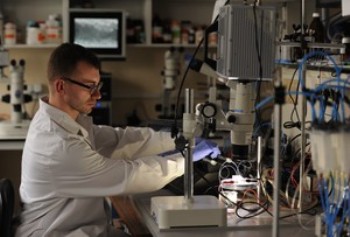Researchers at the Institute of Physical Chemistry of the Polish Academy of Sciences (IPC PAS) have discovered the laws that govern the process of electrocoalescence and the ways in which the process can be optimised, which is critical for the function of microfluidic devices where chemical reactions are carried out in micro-, nano- or picoliter volumes.
 Tomasz Szymborski at IPC PAS
Tomasz Szymborski at IPC PAS
Electrocoalescence is a phenomenon in which tiny droplets in emulsions easily merge when an alternating electric field is applied. According to Tomasz Szymborski, a PhD student of IPC PAS, enhancing the stabilization of droplets and their ability to merge is the major challenge in microfluidic technologies. He also stated that stabilization can be achieved by using a surfactant, surface active agent, to cover the interface.
However, it is difficult to merge droplets from various reagents selectively to carry out a chemical reaction in a microfluidic system. The researchers investigated the merging of water microdroplets using hexadecane as a carrier liquid. They observed that the merging rate of droplets augmented with the frequency of electric field oscillations and applied voltage. There was a limiting frequency for every voltage, beyond which the droplets attained stability again.
Szymborski stated that the researchers identified a simple function to rapidly calculate the threshold value of the frequency at which merging progressed at its optimal rate. Periodic transportation of ions present in the droplets due to the application of an alternating electric field is responsible for the quick merging of droplets. The ions pull apart the oil-droplet interface at the same time electrically charging it. The droplets merge due to the attraction between oppositely charged droplets despite the presence of stabilizing agents or surfactants.
The findings of the study showed that there is a simple relation existing between the threshold frequency for merging of droplets and the nanoscopic electrostatic screening length. They will assist practical improvement of processes employing electrocoalescence, both in industrial plants and microfluidic devices. They will also simplify formulation of universal laws dealing with the efficacy of electrocoalescence in non-equilibrium systems such as flowing liquids.